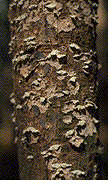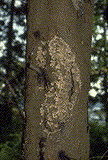Archived Content
Information identified as archived on the Web is for reference, research or recordkeeping purposes. It has not been altered or updated after the date of archiving. Web pages that are archived on the Web are not subject to the Government of Canada Web Standards. As per the Communications Policy of the Government of Canada, you can request alternate formats on the Contact Us page.
Red Heart Rot
Stereum sanguinolentum (Albertini & Schwein.:Fr.) Fr.
(= Haematostereum sanguinolentum (Albertini & Schwein.:Fr.) Pouza))
(=Stereum balsameum Peck)
Basidiomycotina, Aphyllophorales, Stereaceae
Hosts: In B.C., Stereum sanguinolentum has been reported on lodgepole, ponderosa, and western white pine, white and Engelmann spruce, western redcedar, western and mountain hemlock, Douglas-fir, western larch, tamarack, and subalpine, amabilis, and grand fir. In other parts of North America it has also been found on Sitka spruce, alder, and Amelanchier.
Distribution: This fungus is widely distributed throughout the range of its hosts in B.C.
Identification: Fruiting bodies (Figs. 26a, 26b) are common on the lower side of fallen dead branches, log ends and on the face of infected wounds and are occasionally found on dead standing trees. They are annual, leathery, and resupinate to effused-reflexed, often forming thin, crust-like layers. In the effused-reflexed form, the upper surface is grey to light brown and zoned the lower surface is wrinkled, grey to light brown, turning blood red when bruised, hence the common name "bleeding fungus."
The incipient stage of the decay is firm and appears as a red-brown heartwood stain. In the advanced stage the wood becomes light brown to red-brown and soft and fragile in texture. Thin white mycelial fragments may develop in association with advanced decay. Finally, the wood becomes a brown, fibrous, stringy mass.
Microscopic Characteristics: Hyphae in the context of the fruiting body thin-walled, hyaline to pale-yellow, simple septate, or thick-walled, rarely septate. Basidiospores are hyaline, cylindrical, smooth, amyloid. Basidiospore size varies among specimens, either large (8-14 x 3-5 µm,) or more commonly, small. (5-7 x 2-3.5 µm). Growth in culture moderate, mat white to buff, laccase positive, multiple clamp connections present. Stalpers: (1) 3 (7) (8) (11) (12) (13) 14 (15) 17 (18) (19) 21 (22) 24 (25) 30 31 (34) (35) (36) (38) (39) (40) 41 42 44 (48) 50 (51) 52 53 54 (60) (67) (73) (82) 83 90 (92) 96 98 100.
Damage: Red heart rot is responsible for extensive heart rot in mature pine, spruce, and true firs. In other hosts it is largely a slash-destroyer, although it may occasionally be responsible for heartwood stain and terminal die-back.
Remarks:Stereum sanguinolentum is commonly associated with runing wounds, logging scars, and lesions formed as a result of climatic injury. It has also been reported to gain entry through root injuries. Fruiting bodies of S. sanguinolentum can be distinguished from those of Chondrostereum purpureum, a fungus that appears somewhat similar, by the deep red colour of the bruised lower surface of the former. In addition, S. sanguinolentum is usually found on conifers, C. purpureum on hardwoods.
References:
Etheridge, D. E. 1973. Wound parasites causing tree decay in British Columbia. Can. For. Serv., Forest Pest Leaf. No. 62. Victoria, B.C.
Nakasone, K. K. 1990. Cultural studies and identification of wood-inhabiting Corticiaceae and selected Hymenomycetes from North America. J. Cramer, Berlin.
Lentz, P. L. 1955. Stereum and allies genera of fungi in the upper Mississippi valley. USDA For. Serv., Agric. Mon. 24.
Figures
Click on any image to see the full size version.
Press "Back" on your browser to return to this screen.

Figure 26a: Fruiting bodies of Stereumsanguinolentum.
 Figure 26b: Fruiting bodies of Stereum sanguinolentum.
Figure 26b: Fruiting bodies of Stereum sanguinolentum.
 This Web page has been archived on the Web.
This Web page has been archived on the Web.